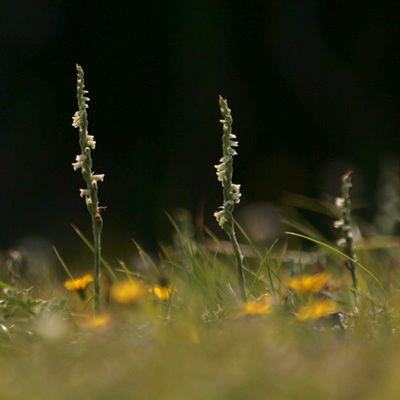Portland Tourism
Discover: Portland's flora & fauna
Wildlife watching & observing is incredibly popular on Portland. This is mostly due to the island's unique coastal location. The Isle of Portland has an extensive range of flora and fauna. The coastline and disused quarries are designated as Sites of Special Scientific Interest.
Wildlife watching & observing is incredibly popular on Portland. This is mostly due to the island's unique coastal location. The Isle of Portland has an extensive range of flora and fauna. The coastline and disused quarries are designated as Sites of Special Scientific Interest.
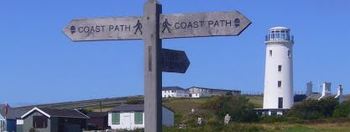
Bird watching - The Portland Bird Observatory sits in the old lower lighthouse and makes an ideal spot for observing the many species of birds that visit Portland. Portland Bird Observatory and Field Centre is an independent organisation and a UK registered charity. The Observatory keeps a comprehensive list of all species spotted on Portland - a total of 355 species are listed, not bad for an area less than 5 miles by 1.5 miles in size! As well as being the centre for bird watching on Portland the observatory also branches out to cover insects, plants and mammals of which Portland has many rare and some unique species. The observatory includes a comprehensive bookshop and staff are incredibly knowledgeable and always open to share their knowledge.
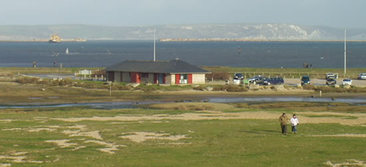
Fine Foundation Chesil Beach Centre is an excellent base and with Portland Harbour, the Fleet Lagoon and Chesil Bank with all their natural assets including salt marsh, lagoon, scrub and grassland, seabirds and waders, cross channel migration makes for a wide variety of birds to spot within one easy location. Having said that,, Chesil Beach stretches along the coastline for 18 miles enclosing the Fleet Lagoon. Access to some of the reserve is restricted during certain time of the year to protect the breeding of sensitive species. Information and permits area available from the Fleet Warden who is situated at the Centre. Guided walks can be arranged.
Marine visitors to the surrounding area include dolphins, seals and basking sharks.
Marine visitors to the surrounding area include dolphins, seals and basking sharks.
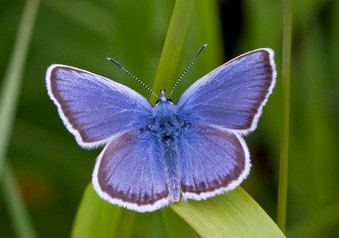
The comparatively warm and sunny climate allows species of plant to thrive which do not on the mainland. The limestone soil has low nutrient levels, hence smaller species of wild flowers and grasses are able to grow in the absence of larger species.
The wild flowers and plants make an excellent habitat for butterflies, over half of the British Isles 57 butterfly species can be seen on Portland, including varieties that migrate from mainland Europe. Species live on Portland that are rare in the United Kingdom, including the Silver Studded Blue.
Perryfield Butterfly Reserve - is a small limestone habitat reserved and nurtured to attract butterflies. The area is set up to include a 400 metre walk made up of 5 sections which includes some small slopes and steps. The area attracts a large variety of butterflies including the Small Skipper, Large Skipper, Small White, Small Blue, Chalkhill Blue, Red Admiral, Painted Lady, Small Tortoiseshell, Peacock, Speckled Wood, Wall, Marbled White, Meadow Brown and Ringlet. To find parking for the reserve, continue along Wakeham to its conclusion and opposite the museum you will find a public car park.
Broadcroft Butterfly Reserve - From the Visitor Centre follow the A354 towards Easton, take Grove Road on the left. 300 yards on the right, in front of Grove Terrace, is a road beside the recreation ground leading to the car park for the Reserve. The entrance to the Butterfly Reserve is marked by a noticeboard. A walk of approximately 1 mile will take you around the reserve but be aware there is an active quarry road through the middle of the reserve. Butterflies spotted within the reserve include the Small Skipper, Lulworth Skipper, Large Skipper, Dingy Skipper, Small Copper, Small Blue, Silver-studded Blue, Common Blue, Chalkhill Blue, Speckled Wood, Wall, Marbled White, Grayling, Gatekeeper, Meadow Brown, Small Heath and Ringlet.
The wild flowers and plants make an excellent habitat for butterflies, over half of the British Isles 57 butterfly species can be seen on Portland, including varieties that migrate from mainland Europe. Species live on Portland that are rare in the United Kingdom, including the Silver Studded Blue.
Perryfield Butterfly Reserve - is a small limestone habitat reserved and nurtured to attract butterflies. The area is set up to include a 400 metre walk made up of 5 sections which includes some small slopes and steps. The area attracts a large variety of butterflies including the Small Skipper, Large Skipper, Small White, Small Blue, Chalkhill Blue, Red Admiral, Painted Lady, Small Tortoiseshell, Peacock, Speckled Wood, Wall, Marbled White, Meadow Brown and Ringlet. To find parking for the reserve, continue along Wakeham to its conclusion and opposite the museum you will find a public car park.
Broadcroft Butterfly Reserve - From the Visitor Centre follow the A354 towards Easton, take Grove Road on the left. 300 yards on the right, in front of Grove Terrace, is a road beside the recreation ground leading to the car park for the Reserve. The entrance to the Butterfly Reserve is marked by a noticeboard. A walk of approximately 1 mile will take you around the reserve but be aware there is an active quarry road through the middle of the reserve. Butterflies spotted within the reserve include the Small Skipper, Lulworth Skipper, Large Skipper, Dingy Skipper, Small Copper, Small Blue, Silver-studded Blue, Common Blue, Chalkhill Blue, Speckled Wood, Wall, Marbled White, Grayling, Gatekeeper, Meadow Brown, Small Heath and Ringlet.
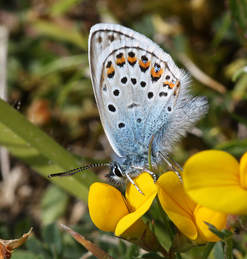
King Barrow Quarries & Nature Reserve
King Barrow’s rocky slopes, grassy pockets and sheltered gullies provide havens for wildlife. Thin limestone soils have been slowly colonised by a variety of wildflowers with brilliant displays of colour in spring and early summer. Rare plants, butterflies and even lichens make this quarry a unique reserve.
The plants are often dominated by pinks, such as low growing Wild Thyme, straggling Rest Harrow and spikes of Pyramidal Orchids, or yellows, such as Lady’s Bedstraw, Kidney and Horseshoe Vetches and Birds-foot Trefoil. Standing upright are the bright blue flowers of Vipers Bugloss. The shadier gullies encourage Hart’s Tongue Fern, Wood Spurge and the unusual Ivy Broomrape, a parasite of Ivy. Taller scrub of Wild Privet, Buddleia, Wayfaring Tree and Sycamore are found throughout the quarry. The non-native and highly invasive Cotoneaster shrub is being removed where possible. Butterflies are attracted by nectar, food plants and warm slopes and the quarry supports many species; Speckled Wood in dappled shade, Marbled White in longer grass and delicate blue butterflies on shorter turf and open rocky areas including Chalkhill, Small and Common Blue and Portland’s special Silver-Studded Blue. In late summer, the migrant Clouded Yellow Butterfly may be seen. The ‘beaches’ are used by Slow Worms, Common Lizards and for nesting, by Little Owls.
King Barrow’s rocky slopes, grassy pockets and sheltered gullies provide havens for wildlife. Thin limestone soils have been slowly colonised by a variety of wildflowers with brilliant displays of colour in spring and early summer. Rare plants, butterflies and even lichens make this quarry a unique reserve.
The plants are often dominated by pinks, such as low growing Wild Thyme, straggling Rest Harrow and spikes of Pyramidal Orchids, or yellows, such as Lady’s Bedstraw, Kidney and Horseshoe Vetches and Birds-foot Trefoil. Standing upright are the bright blue flowers of Vipers Bugloss. The shadier gullies encourage Hart’s Tongue Fern, Wood Spurge and the unusual Ivy Broomrape, a parasite of Ivy. Taller scrub of Wild Privet, Buddleia, Wayfaring Tree and Sycamore are found throughout the quarry. The non-native and highly invasive Cotoneaster shrub is being removed where possible. Butterflies are attracted by nectar, food plants and warm slopes and the quarry supports many species; Speckled Wood in dappled shade, Marbled White in longer grass and delicate blue butterflies on shorter turf and open rocky areas including Chalkhill, Small and Common Blue and Portland’s special Silver-Studded Blue. In late summer, the migrant Clouded Yellow Butterfly may be seen. The ‘beaches’ are used by Slow Worms, Common Lizards and for nesting, by Little Owls.
The Verne local nature reserve
The peaceful slopes of the Verne and Old Hill, were once the scene of a remarkable reshaping of the landscape, creating a fascinating heritage of industrial archaeology and natural history. The land has been declared a Local Nature Reserve by the local authority, in recognition of its value for wildlife and local people.
The peaceful slopes of the Verne and Old Hill, were once the scene of a remarkable reshaping of the landscape, creating a fascinating heritage of industrial archaeology and natural history. The land has been declared a Local Nature Reserve by the local authority, in recognition of its value for wildlife and local people.
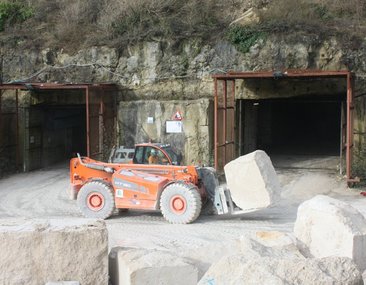
Portland Stone
Famous worldwide, Portland Stone has been extracted from the Island for many years. Portland’s iconic stone has been used for centuries on many world-famous buildings, including St Pauls Cathedral, Buckingham Palace and the UN Building in New York.
The Island’s stones are known to have been first used on local project such as Rufus Castle, Exeter Cathedral and Portland Castle. The demand for Portland Stone in London increased after the Great Fire in 1666 and in the eighteenth century quarries on the north eastern coast of the Island opened up, with further quarries opening during the nineteenth and twentieth centuries in the centre of the Island.
Portland stone is still extracted from the Island today. In recent years, as technology has advanced, new extraction techniques are being used on the Island to extract Portland Stone. Along with open quarrying methods, mining is one of these modern extraction techniques. The mining of Portland Stone is more environmentally friendly and avoids disturbance to the extraction site at surface level.
Recent Portland Stone projects include: Green Park Tube Station, the British Museum and BBC Broadcasting House in London. Other worldwide Portland stone projects include: the National Gallery of Ireland and the British Memorial Garden in New York.
Local companies that still quarry Portland stone include Albion Stone & Stone Firms.
Famous worldwide, Portland Stone has been extracted from the Island for many years. Portland’s iconic stone has been used for centuries on many world-famous buildings, including St Pauls Cathedral, Buckingham Palace and the UN Building in New York.
The Island’s stones are known to have been first used on local project such as Rufus Castle, Exeter Cathedral and Portland Castle. The demand for Portland Stone in London increased after the Great Fire in 1666 and in the eighteenth century quarries on the north eastern coast of the Island opened up, with further quarries opening during the nineteenth and twentieth centuries in the centre of the Island.
Portland stone is still extracted from the Island today. In recent years, as technology has advanced, new extraction techniques are being used on the Island to extract Portland Stone. Along with open quarrying methods, mining is one of these modern extraction techniques. The mining of Portland Stone is more environmentally friendly and avoids disturbance to the extraction site at surface level.
Recent Portland Stone projects include: Green Park Tube Station, the British Museum and BBC Broadcasting House in London. Other worldwide Portland stone projects include: the National Gallery of Ireland and the British Memorial Garden in New York.
Local companies that still quarry Portland stone include Albion Stone & Stone Firms.
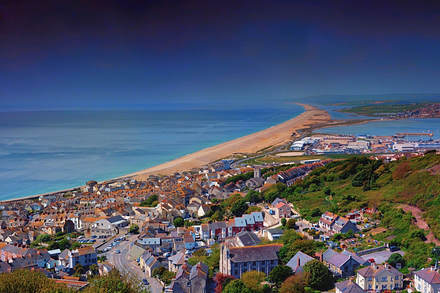
Chesil Beach & The Fleet
Chesil Beach is 18 miles in length, roughly 160 metres wide and rises to 12 metres in height. It is a pebble and shingle tombolo, to give it its technical name, which means a deposition landform such as a spit or bar which is attached to the mainland by a narrow piece of land. Chesil beach connects Portland to Abbotsbury and then continues north-westwards to West Bay. It is the largest tombolo in the UK and without it Portland really would be an island!
Running along approximately 8 miles of Chesil Beach is an area known as the Fleet, from the Saxon fleot meaning shallow water. The Fleet covers 480 hectares, is never more than 5 metres deep with the majority being around 2 metres in depth. The Fleet connects to the sea at Ferrybridge that feeds into Portland harbour. Here the water is as normal sea water but at the upper end of the Fleet near Abbotsbury the water only has about half the salt content of seawater. The Fleet is an important area for wildlife and is a special area of conservation (SAC), a special protection area (SPA) under the EU birds directive, a site of special scientific interest (SSSI), Ramsar List of Wetlands of International Importance and a designated bass nursery area. Unsurprisingly with all these protections the area is a have for wildlife both on land, in the air and in the sea. There are over 150 species of seaweed and 25 species of fish in the Fleet, whilst 5000 Brent Geese make the area their winter home.
The pebbles vary in size along the length of Chesil beach with fist size pebbles at the Portland end to pea size pebbles at West Bay. The pebbles are made up of many different types of rock including flint, chert, quartzite, granite, porphyry, tourmalised rock, breccia, Portland stone, pumice, jasper, agate and madrepores.
The seaward face of the beach is steeply shelving and this continues below the sea level until it gradually levels off at around 18 metres below sea level some 300 metres offshore in the southern part of the beach. Further north the offshore depth is around 11 metres. The beach stabilised close to its present position some 5000 years ago and since then it has been advancing slowly towards the mainland. Under storm conditions large quantities of pebbles can be removed from the beach onto the seabed. For severe storms the quantities can exceed 3 Million tonnes.
Chesil Beach is 18 miles in length, roughly 160 metres wide and rises to 12 metres in height. It is a pebble and shingle tombolo, to give it its technical name, which means a deposition landform such as a spit or bar which is attached to the mainland by a narrow piece of land. Chesil beach connects Portland to Abbotsbury and then continues north-westwards to West Bay. It is the largest tombolo in the UK and without it Portland really would be an island!
Running along approximately 8 miles of Chesil Beach is an area known as the Fleet, from the Saxon fleot meaning shallow water. The Fleet covers 480 hectares, is never more than 5 metres deep with the majority being around 2 metres in depth. The Fleet connects to the sea at Ferrybridge that feeds into Portland harbour. Here the water is as normal sea water but at the upper end of the Fleet near Abbotsbury the water only has about half the salt content of seawater. The Fleet is an important area for wildlife and is a special area of conservation (SAC), a special protection area (SPA) under the EU birds directive, a site of special scientific interest (SSSI), Ramsar List of Wetlands of International Importance and a designated bass nursery area. Unsurprisingly with all these protections the area is a have for wildlife both on land, in the air and in the sea. There are over 150 species of seaweed and 25 species of fish in the Fleet, whilst 5000 Brent Geese make the area their winter home.
The pebbles vary in size along the length of Chesil beach with fist size pebbles at the Portland end to pea size pebbles at West Bay. The pebbles are made up of many different types of rock including flint, chert, quartzite, granite, porphyry, tourmalised rock, breccia, Portland stone, pumice, jasper, agate and madrepores.
The seaward face of the beach is steeply shelving and this continues below the sea level until it gradually levels off at around 18 metres below sea level some 300 metres offshore in the southern part of the beach. Further north the offshore depth is around 11 metres. The beach stabilised close to its present position some 5000 years ago and since then it has been advancing slowly towards the mainland. Under storm conditions large quantities of pebbles can be removed from the beach onto the seabed. For severe storms the quantities can exceed 3 Million tonnes.
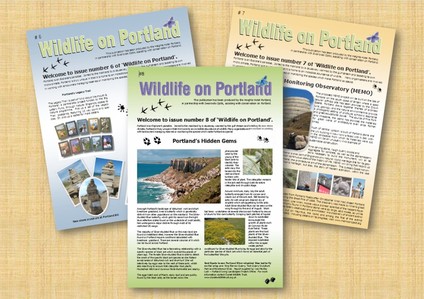
Wildlife on Portland
Check out the 'Wildlife on Portland' brochure, detailing Portland's flora and fauna. Available now, from the Visitor Information Centre, at The Heights Hotel.
Discover details about wildlife you never knew existed on the island, as well as news about exciting projects coming to Portland.
Check out the 'Wildlife on Portland' brochure, detailing Portland's flora and fauna. Available now, from the Visitor Information Centre, at The Heights Hotel.
Discover details about wildlife you never knew existed on the island, as well as news about exciting projects coming to Portland.




